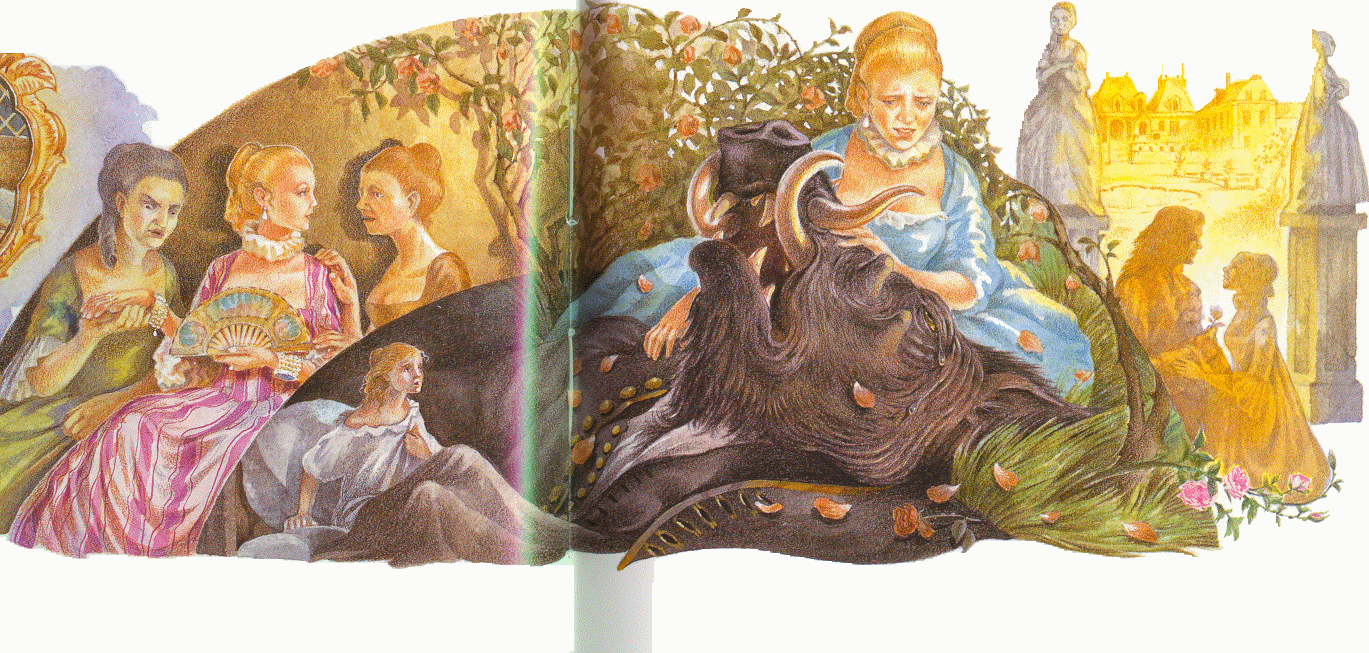Everyone knows the classic fairytale Beauty and the Beast. The original story was written in 1757 by the French author Jeanne-Marie LePrince de Beaumont. Since then, various versions have been conducted from across the globe. Some of my favorites derive from France, England, Russia, Italy, and Germany. Here are the ones I found!
1. La Belle et La Bête (France)
The original version is quite different from the Disney version we all know and love. In this story, the merchant has three daughters and they suddenly lose all their fortune. When their father learns he could possibly gain back some of his fortune, the girls ask for lots of expensive things but Beauty, the youngest, wants only a single rose.
The beast caught the father stealing the rose for Beauty and let him go under that condition that he bring him back his daughter whom the rose was for. Beauty then becomes a prisoner in the beast's castle and is treated very well. The beast, however, does not show his face until one night in the garden, leaving Beauty frightened but still wishing he wouldn't hide himself away anymore. When the beast becomes ill, Beauty agrees to marry him and he transforms into the handsome prince he once was before he was cursed.
2. The Small-Tooth Dog (England)
The English version, written by Sidney Oldall Addy, is a very obscure and twisted tale. It begins with the merchant suffering an attack by thieves when suddenly a large dog appears and saves his life by driving the thieves away. The dog then takes the merchant back to his home and nurses him back to health. When the merchant tries to repay him in any way he can, the dog wants nothing. His only wish is for the merchant to take him to his daughter so he can take her back to his home, and, the merchant complies.
The merchant's daughter is held captive at the dog's home for a month until she cries and begs to see her father until the dog agrees to take her home if she stays for only three days. In addition, she must tell him that he is "sweet as a honeycomb" before they depart and once they arrive. She manages to say it before, but after she instead calls him "a great, foul, small-tooth dog." When she finally manages to call him "sweet as a honeycomb" upon their arrival, the dog transforms into a handsome human man. The two fall in love and get married and live happily ever after.
3. The Enchanted Tsarevich (Russia)
Written by Alexander Afanasyev, this Russian tale features a snake as the villain rather than a beast. The merchant had three daughters and upon departing for his journey, he asked each daughter what they would like him to bring back for them when he returns. The eldest two ask for expensive things while the youngest draws a picture of a flower and asks for a real one that resembles the drawing.
When the merchant finds the flower in the snake's garden, he angers the three-headed snake and must return home under the condition that the first person he sees become the snake's prisoner. The youngest daughter is the first person the merchant sees, and so, he takes her to the snake. Now a prisoner of the snake trapped in his castle, the girl is visited by the snake at night in her bedroom and asks her to perform various tasks, such as moving the bed and allowing the snake to lie next to her in bed.
The snake soon softens a bit and allows the young girl to spend a day at home as long as she is not late to return or the snake will die of grief, so he claims. The girl stays home longer than she had promised, spending the night at home, therefore staying for two days. When she returns, the snake is dead in the water of his garden. He had thrown himself in there to drown out of grief. The girl grabbed one of the snake's heads and kissed him, transforming him into a young prince. They marry and live happily ever after.
4. Zelinda and the Monster (Italy)
The Italian fairytale Zelinda and the Monster, written by Thomas Frederick Crane, begins and ends much like that of Afanasyev's version of the tale. The merchants eldest daughters ask for expensive things while the youngest, Zelinda, asks for a rose. Not a beast nor a snake, but a monster greets the merchant with haste upon catching him in the act of stealing from his rosebush. The merchant is then told he must die or the one who requested the rose must die. The merchant returns home and Zelinda takes his place.
Expected to be killed by the monster, Zelinda was instead caressed by the monster as he told her he wanted her to be his wife. Although Zelinda liked him, she did not love him because she could not ignore his ugliness. It is not until the monster calls Zelinda in hysteria and informs her that if she does not marry him her father will die that she complies. Upon accepting the monster's marriage proposal, the monster transforms into a handsome young man and tells Zelinda of the curse he was under that made him into the monster that he was. She broke the curse by agreeing to marry him and they lived happily ever after.
5. The Summer and Winter Garden (Germany)
This German story is much like Crane's version with only a handful of discrepancies. Written by the Grimm brothers, Jacob and Wilhelm, it begins the same as many, with the merchant going off to a fair and the youngest daughter asking for him to bring her back a rose. It was the middle of winter, but on his trip he comes across a garden where it is winter on one side and summer on the other.
Wandering into the summer half, he picks a rose for his daughter but a big, black beast comes charging at him to return the rose or he will die. When the merchant pleads to keep the rose because he must bring it back for his daughter, the beast gives him an ultimatum; give back the rose or give the beast his daughter's hand in marriage. The merchant keeps the rose so the beast warns him that in eight days he will come to fetch his daughter and marry her. The merchant believed the beast was bluffing but, sure enough, eight days later he came for the girl. The girl asks to see her family and in response, the beast brings her a mirror that lets her see her family in their living room at home.
Eventually he allows her to go home for eight days and no longer, but she stays much longer due to her depression over her father's death. She goes to seek out the beast and finds him dead in his garden that is now all covered in snow and plagued by winter. The girl pours water over the beast and he suddenly arises and transforms into a human. Now a handsome prince, the two marry and live happily ever after.
It is interesting to see how countries from all over the world can take one fairytale and create copious versions, all following a similar storyline and message while also adding their own twist. Each version is unique in it's own way; some are wildly obscure and some are extremely close to the original. All in all, there is so much history behind fairytales and their origins that goes unnoticed but we should be appreciative of this worldwide connecting link.


















































